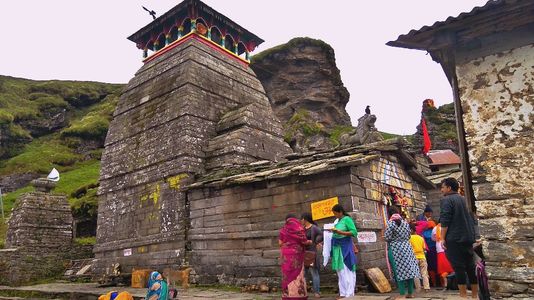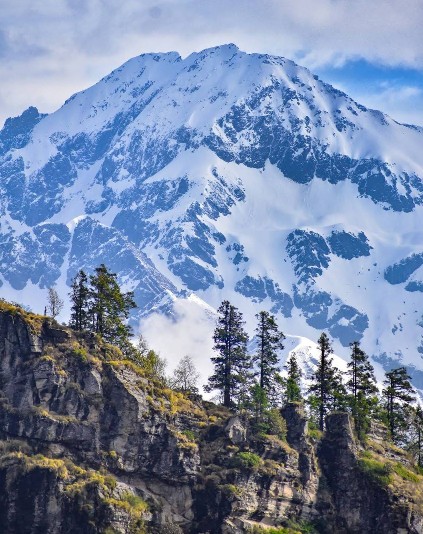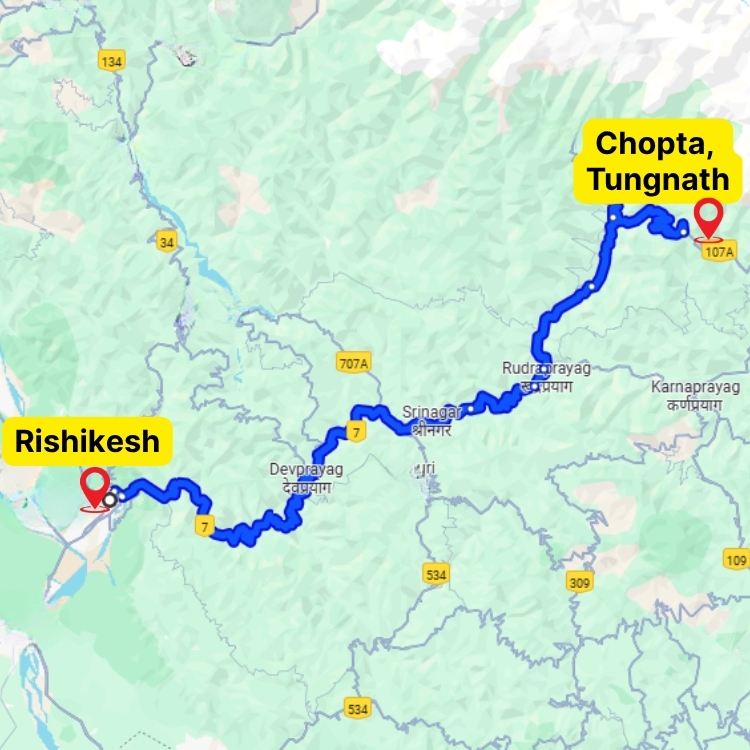Tungnath Temple Guide | Trek, Height, Distance & Weather
 Mountains Curve
08 Aug, 2025
14 mins read
115
Mountains Curve
08 Aug, 2025
14 mins read
115

Tungnath Temple is one of the most enchanting places in Uttarakhand, combining deep spiritual significance with the raw beauty of the Himalayas. Known as the highest Shiva temple in the world, it stands proudly at an altitude of about 3,680 meters in the Rudraprayag district. Perched in the lap of the Garhwal Himalayas, Tungnath is not just a religious destination, it is also a trekking paradise, attracting devotees, adventure seekers, and nature lovers alike.
Trek Route Overview
The Tungnath Trek route stretches about 3.5 km from Chopta to Tungnath Temple, taking roughly 3 to 4 hours to complete. Starting at an altitude of around 2,680 meters in Chopta, the trail gently climbs to 3,680 meters, passing through lush alpine meadows, oak and rhododendron forests, and offering clear views of snow-capped Himalayan peaks. The path is well-defined and graded easy to moderate, making it suitable for both beginners and experienced trekkers. When starting from Yog Nagari Rishikesh, the entire trip generally takes 3 days, one day to drive to Chopta, one day for the trek to Tungnath (with an optional extension to Chandrashila Peak), and the final day for the return journey.
Location and Altitude
- District: Rudraprayag, Uttarakhand
- Altitude: 3,680 meters (12,073 feet)
- Nearest Town: Chopta (about 4 km away)
Tungnath is surrounded by breathtaking views of snow-covered Himalayan peaks like Nanda Devi, Chaukhamba, Trishul, and Kedarnath.
Tungnath Trekking Itinerary
- Day 1: Drive from Rishikesh to Chopta
- Day 2: Trek from Chopta to Tungnath Temple and Chandrashila, then back to Chopta
- Day 3: Drive from Chopta and back to Rishikesh
History and Mythological Significance
Tungnath holds a prominent place in Hindu mythology. According to the legends of the Panch Kedar, the Pandavas built this temple to worship Lord Shiva and seek his blessings for absolution after the Kurukshetra war. It is believed that arms of the Lord Shivaappeared here, while his other body parts manifested at the other four Panch Kedar temples - Kedarnath, Rudranath, Madhyamaheshwar, and Kalpeshwar.
Architecture of the temple reflects the traditional North Indian style, built with stone walls and a wooden roof, exuding a timeless charm that has survived for centuries.
An Overview about Panch Kedar
Panch Kedar Yatra is a revered pilgrimage in the Garhwal Himalayas of Uttarakhand, where devotees visit five sacred temples dedicated to Lord Shiva. Among them, Kedarnath Temple holds special significance as part of the Chota Char Dham circuit and one of the twelve Jyotirlingas. The journey begins with a road trip to Gaurikund, followed by the challenging trek to Kedarnath, the high-altitude climb to Tungnath, the forested trails to Rudranath, the scenic meadows of Madhyamaheshwar, and remote village routes like Ransi and Sagar. Spanning around 95 kilometers over 10 to 11 days, this pilgrimage attracts Shiva devotees of all ages, blending spiritual devotion with the adventure of Himalayan trekking.
Best Time to Visit Tungnath
The best time to visit Tungnath is from May to June and from September to October, when the weather is pleasant, the scenery is beautiful, and the trek is easy to do. During these months, the meadows are green, rhododendrons are bright, and the skies are clear, giving amazing views of the Himalayas. Summer brings the most visitors, as pilgrims and trekkers come to the temple in good weather without snow or heavy rain. Monsoon is better to avoid because of rain, clouds, and the chance of landslides, but if the weather is clear, no other time can match its beauty. Winter covers the area in snow, but the very cold weather and difficult trek make it right only for experienced trekkers.

Tungnath in Summer (April to June)
- Season Highlights:
- Peak tourism season.
- Chopta (trek base) is at its greenest and most scenic.
- 3.5 km uphill trek offers stunning views.
- Weather: Pleasant, around 16 degree celcius; no rain or snow.
- Flora: Rhododendrons in full bloom (especially in June).
- Best for: Pilgrimage, comfortable trekking, photography.
Tungnath in Monsoon (July to September)
- Rainfall: Scanty to moderate rain.
- Pros: Less crowd.
- Cons:
- Cloudy skies block mountain views.
- Risk of landslides.
- Recommendation: Travel with caution; not ideal for scenic photography.
Tungnath in Winter (November to March)
- Weather:
- Day: 10 degree to 12 degree celcius
- Night: Can drop to -15 degree celcius.
- Conditions:
- Heavy snowfall; thick snow cover.
- Trekking is challenging but scenic.
- Best for: Adventure seekers and snow lovers.
- Preparation: Carry multiple warm clothing layers.
How to Reach Tungnath

To reach Tungnath, first reach Rishikesh which is well connected with the major cities in India.
Modes of Transport to Reach Rishikesh
- By Road
- Well-connected via NH 334 from Delhi and other major North Indian cities.
- Approx. 240 km from Delhi; takes 6 to 7 hours by car or bus.
- Frequent Volvo, deluxe, and state transport buses from ISBT Kashmiri Gate, Delhi.
- Direct road links from cities like Haridwar, Dehradun, Chandigarh, and Meerut.
- By Train
- The nearest railhead is Rishikesh Railway Station (~205 km from Tungnath). From there, take a taxi, bike, or bus to Chopta and then trek to Tungnath.
- By Air
- Nearest airport: Jolly Grant Airport, Dehradun (~223 km from Tungnath). From the airport, hire a taxi or take a bus to Chopta.
Road Route from Rishikesh to Tungnath
1. Rishikesh to Ukhimath
- Distance: ~180 km
- Route: Rishikesh - Devprayag - Srinagar - Rudraprayag - Agastyamuni - Ukhimath.
- Ukhimath is the winter seat of Lord Kedarnath and an important pilgrimage stop.
2. Ukhimath to Chopta
- Distance: ~30 km
- Scenic drive through deodar and rhododendron forests.
- Chopta is the base camp for the Tungnath trek.
3. Chopta to Tungnath (Trek)
- Distance: ~3 km | Time: 2 to 3 hours
- Moderate trek with beautiful Himalayan views.
Where to Stay in Tungnath
There are no hotels at Tungnath itself. Visitors usually stay at Chopta, which has guesthouses, camps, and homestays. During peak season, it is best to book accommodation in advance.
Travel Tips for Tungnath Visit
- Start your trek early to avoid afternoon fog and get the best views.
- Carry water and light snacks, as there are limited stalls on the way.
- Dress in layers to adjust to rapid weather changes.
- Respect the sanctity and local customs of the temple.
- If heading to Chandrashila, check weather and snow conditions.
Places to Visit Nearby
- Chandrashila Peak: A short trek from Tungnath leading to a summit offering breathtaking 360-degree Himalayan views, including Nanda Devi, Trishul, and Chaukhamba peaks.
- Rohini Bugyal: A scenic alpine meadow en route to Deoriatal, known for lush greenery, wildflowers, and serene Himalayan views.
- Deoriatal: A crystal-clear lake reflecting Chaukhamba peaks, ideal for photography, camping, and birdwatching.
- Sari Village: A quaint Garhwal village, base point for Deoriatal trek, known for traditional wooden houses and warm local hospitality.
Frequently Asked Questions About Tungnath
Q. 1 What is special about Tungnath Temple?
Ans. Tungnath is the highest Shiva temple in the world, located at 3,680 m, and one of the Panch Kedar temples believed to be built by the Pandavas.
Q. 2 Where is Tungnath Temple located?
Ans. It is situated in the Rudraprayag district of Uttarakhand and accessible via a trek from Chopta (base camp).
Q.3 What is the altitude of Tungnath Temple?
Ans. Tungnath Temple is perched at approximately 3,680 meters (12,073 feet) above sea level.
Q. 4 How long is the trek to Tungnath?
Ans. From Chopta, it is about a 3.5 to 4 km trek, taking 1.5 to 2 hours one way, with moderate difficulty and suitable for beginners.
Q. 5 When is the best time to visit Tungnath?
Ans. Ideal months are May to June and September to October when skies are clear and weather is pleasant.
Q. 6 Is Tungnath Temple open in winter?
Ans. No. It closes during winter (November to April) due to heavy snowfall and the deity is shifted to Makkumath.
Q. 7 What are its temple opening dates?
Ans. Generally, it opens in May first week and closes in end of the November.
Q. 8 Are there any entry fees?
Ans. Some sources mention an entry fee of rs. 200 per person before the trek through the forest reserve.
Q. 9 What accommodations are available near Tungnath?
Ans. Lodging is available in Chopta - guesthouses, camps, homestays, and simple hotels. Closest overnight stay by temple is limited.
Q. 10 Can I trek during monsoon?
Ans. Though lush, monsoon (July to August) brings slippery trails, landslide risks, and poor visibility, so it is generally not advised.
Q. 11 Is the trek safe in winter (snowy conditions)?
Ans. Yes, snow-covered treks are possible but require good gear like sturdy shoes and winter attire.
Q. 12 What wildlife can be spotted around Tungnath?
Ans. The region is rich in Himalayan fauna, watch for Monal, Koklass and Kalij pheasants, musk deer, langurs, and diverse birdlife.
Q. 13 Can non-Hindus visit Tungnath?
Ans. Absolutely. Visitors of all backgrounds are welcome; devotees and tourists alike visit without barriers.
Q. 14 Can I go to Chandrashila Peak from Tungnath?
Ans. Yes, a further 1.5 km trek from Tungnath leads to Chandrashila, offering breathtaking 360 degree Himalayan views.
Q. 15 Are tea stalls or food available en route?
Ans. Basic food and tea stalls are available along the trek, but packing light snacks and water is recommended.
Written By:
Mountains Curve



Hotels at your convenience
Now choose your stay according to your preference. From finding a place for your dream destination or a mere weekend getaway to business accommodations or brief stay, we have got you covered. Explore hotels as per your mood.





